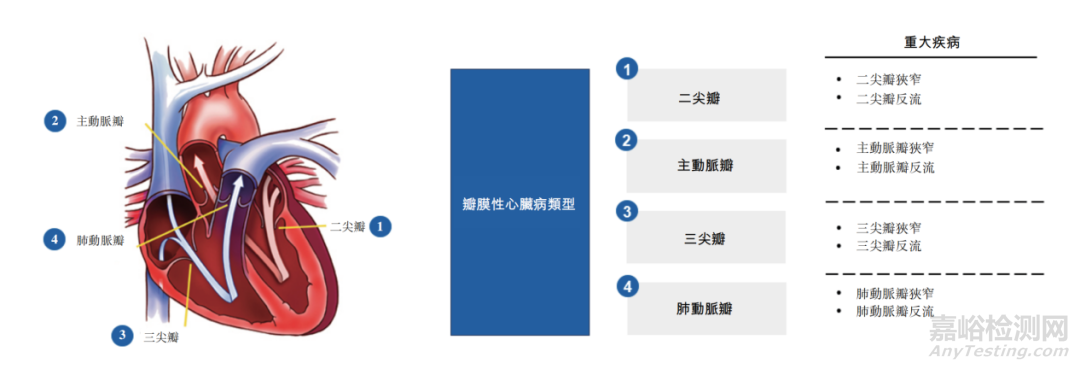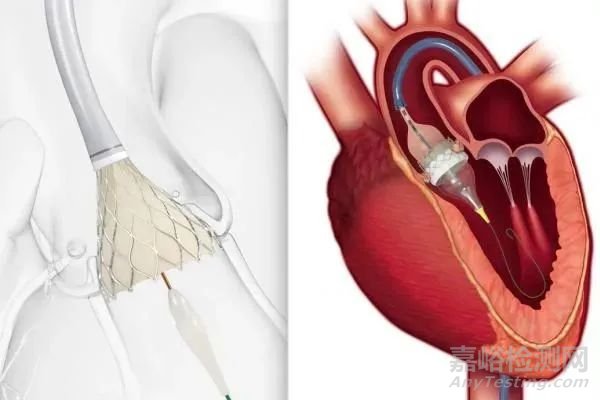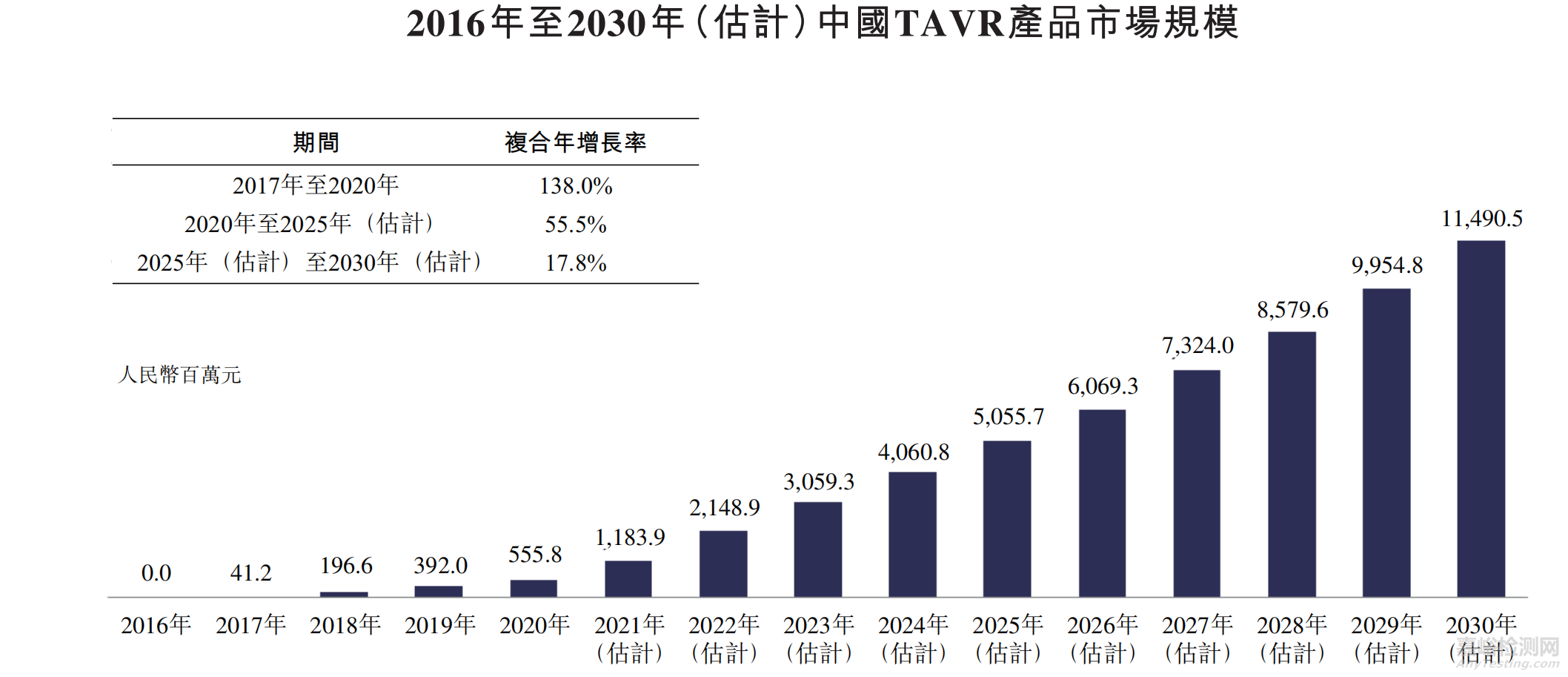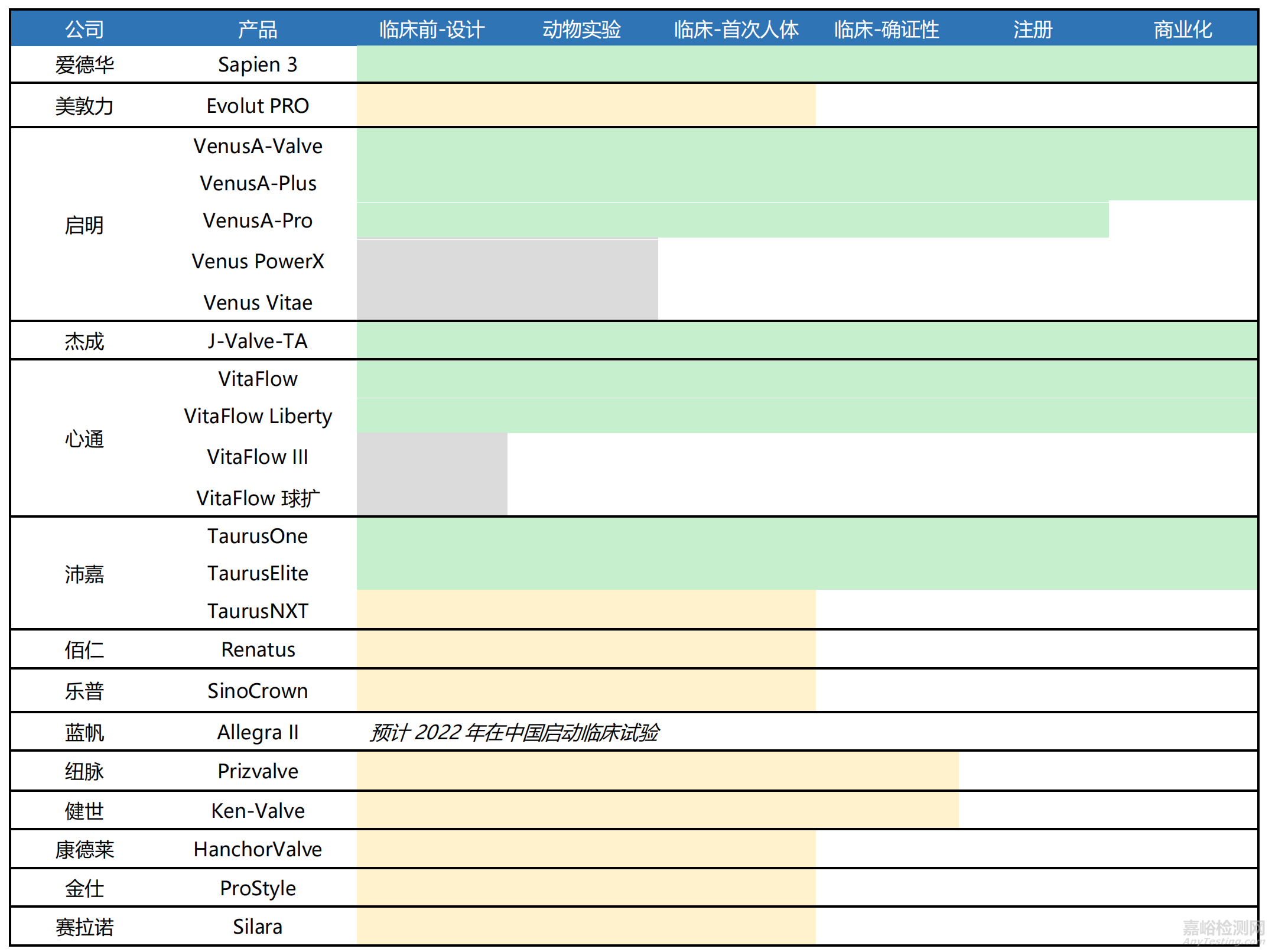您當前的位置:檢測資訊 > 科研開發
嘉峪檢測網 2022-02-17 20:48
前言導讀
結構性心臟病是近年心血管疾病領域提出的一個新概念,2005年由德國法蘭克福的Horst Sievert醫生首先提出,泛指一大類先天性或獲得性的以心臟和大血管結構異常為主要表現的心血管疾病,如傳統定義的先天性心臟病、心臟瓣膜疾病和心肌病等。
廣義的結構性心臟病是指除原發心電疾患(因某些電生理異常而發生的VT/VF)和循環疾病(部分高血壓、穩定性心絞痛、ACS)以外,任何心臟結構的異常,任何與心臟和大血管結構有關的疾病。而狹義的結構性心臟病是指解剖異常引起的心臟結構改變所造成的心臟的病理生理變化。包括:(1)先天性心臟病:室間隔缺損(VSD)、房間隔缺損(ASD)、動脈導管未閉(PDA)等;(2)瓣膜病:二尖瓣、三尖瓣、主動脈瓣、肺動脈瓣等;(3)心肌病:肥厚性心肌病、擴張型心肌病、致心律失常型右室心肌病等;(4)心肌梗塞后室間隔穿孔、室壁瘤、疤痕心肌等。
在過去十年中,結構性心臟病的診斷及治療取得了飛速發展,成為了當今心血管疾病領域的一大亮點,其未來發展引人矚目。
根據弗若斯特沙利文的資料顯示,被廣泛視為針對瓣膜性心臟病高度有效療法的介入式瓣膜手術在中國仍然供不應求,用于該等手術的經導管心臟瓣膜器械亦然。此問題影響了大量未能得到妥善治療的病患,也為合格并致力于改變現狀的醫療器械從業者帶來了可觀的商業機遇。
主動脈瓣介入器械市場概覽
瓣膜性心臟病的特點為四個心臟瓣膜(即主動脈瓣、二尖瓣、三尖瓣及肺動脈瓣)中一個或多個瓣膜出現損傷或缺陷。在這幾個瓣膜中,主動脈瓣控制心臟和主動脈之間的血液流動,從而控制通往身體其他部位的血管;二尖瓣和三尖瓣控制心房和心室之間的血液流動;而肺動脈瓣控制從心臟到肺的血液流動。正常運作的瓣膜可確保適當的血液流動,但瓣膜性心臟病會導致瓣膜變得太窄及硬化(狹窄)而無法完全開啟,或無法完全閉合(反流)。下圖顯示了不同類型的瓣膜性心臟病。

圖片來源:文獻回顧、弗若斯特沙利文報告
在治療方案選擇方面,對于輕度和中度患者,一般疾病早期通過藥物治療延緩疾病的進展。對于重度患者則需要通過手術干預,因為瓣膜性心臟病是一個機械性病癥,相當于心臟這個“泵”的“閥門”壞了,僅通過藥物治療效果有限。
其中,主動脈瓣疾病是相對嚴重的瓣膜病之一,如果患者出現癥狀后不及時干預,中期生存期較短。經導管主動脈瓣膜置換術(Transcatheter aortic valve replacement ,TAVR)是針對主動脈瓣疾病(尤其是主動脈瓣狹窄)的主要治療方法。TAVR手術作為一種介入治療技術,不需要開胸,主要是經過股動脈穿刺,然后通過導管將特制的人工瓣膜送到原有心臟瓣膜的位置,通過球囊擴張釋放后,即刻發揮作用。使用TAVR介入手術植入瓣膜的最大優勢是患者身體接受度高,不需要開胸,從而降低了對病人的整體傷害。其次,介入手術可以在不影響心臟跳動的情況下操作,將人工瓣膜從病人的股動脈血管植入到病變的位置。

TAVR示意圖
對于手術數量和滲透率,根據著名分析機構的相關分析,我國TAVR手術的數量從2017年的200臺增加至2020年的3,600臺,復合年增長率為173.9%,且預計將從2020年的3,600臺增加至2025年的42,000臺及2030年的109,400臺,2020年至2025年的復合年增長率為63.3%且2025年至2030年的復合年增長率為21.1%。我國TAVR手術的滲透率由2017年的0.0%增長至2020年的0.5%,并預計將進一步增長至2025年的4.5%及2030年的10.2%。下表顯示我國TAVR手術的數量及滲透率。

資料來源:文獻回顧、弗若斯特沙利文報告
對于產品市場,根據著名分析機構的相關分析,我國TAVR市場于2020年達到人民幣555.8百萬元,2017年至2020年的復合年增長率為138.0%,TAVR市場預計將于2025年增至人民幣5,055.7百萬元,于2030年增至人民幣11,490.5百萬元,2020年至2025年的復合年增長率為55.5%,而2025年至2030年的復合年增長率為17.8%。下表顯示我國的過往及預測TAVR產品市場:

資料來源:文獻回顧、弗若斯特沙利文報告
TAVR 具備巨大的臨床價值創造、商業價值實現以及高技術壁壘和長期不可替代性,同時,仍在不斷優化迭代技術水平,不斷優化其對于主動脈瓣狹窄和反流的治療效果。可以說,TAVR 是名副其實的長坡厚雪賽道。
不過,雖然目前國內TAVR以及介入瓣膜行業處于發展早期,但是不可否認的是,TAVR市場已經出現了激烈競爭的局面,也出現了各家廠商產品的同質化的現象,下圖為截至至2021年底國內 TAVR 產品管線示意:

圖片來源:蛋殼研究院
在眾多的TAVR產品中,作為心臟瓣膜領域的鼻祖和絕對巨頭-愛德華的SAPIEN 3備受矚目,國外醫療巨頭產品在中國的上市,也將國內TAVR帶入“戰國時代",因此,本文對愛德華的Sapien 3進行聚焦,以饗讀者。
愛德華-Sapien 3概覽
從全球TAVR市場范圍來看上,比較公認的市場格局為:愛德華占比約60%,美敦力占比約30%,雅培、波士頓科學等占剩余10%份額。目前,愛德華陸續已上市的TAVR產品共有兩種——SAPIEN 3、以及SAPIEN 3 Ultra,為標桿級別的器械。2020年6月,愛德華SAPIEN 3在中國獲得NMPA批準,成為首款獲得中國監管機構批準的國外瓣膜產品。

SAPIEN 3示意圖
專利分析
需要特別說明的是,對于心臟瓣膜醫療器械,筆者對國內外各大廠家均進行了詳細研讀和分析,形成了卓有成效的工作成果,基于篇幅原因,本篇文章筆者著重以愛德華的主動脈瓣—SAPIEN 3為例,對心臟瓣膜醫療器械相關專利情況進行簡要說明,如若獲取完整心臟瓣膜醫療器械專利清單與專利分析可以與筆者取得聯系,共同交流學習。
技術脈絡
對于SAPIEN 3技術脈絡,筆者通過如下圖片向各位讀者進行展示:

SAPIEN 3技術脈絡示意圖
技術理解
對于SAPIEN 3技術要點,其主要包括四個主要方面部分,筆者通過如下圖片向各位讀者進行展示:

SAPIEN 3技術要點示意圖
另外,對于SAPIEN 3技術拆解,其裝配關系如下四幅圖所示:



SAPIEN 3技術裝配示意圖
重點專利
根據SAPIEN 3相關重點專利,愛德華對其進行了細致性的專利布局,筆者從涉及的相關專利中分別擇機選擇了3組專利進行了解析,相關結果如下:需要特別說明的是,如若獲取完整專利清單與專利分析情況可以與筆者取得聯系,共同交流學習:
1
|
公開/公告號 |
US5411552B |
申請日 |
1994-06-14 |
|
發明名稱 |
Valve prothesis for implantation in the body and a catheter for implanting such valve prothesis |
||
|
解決的技術問題 |
The valve prosthesis according to the invention does not require an actual operation but merely a small intervention to optionally expose the body channel, e.g., a vein, through which the insertion takes place. Thus, patients for whom an operation would be associated with high risk can be offered implantation of, for instance, cardiac valves. After the implantation has taken place, the after-treatment will advantageously be shorter than normally, which means fewer hospital days for the patient. Moreover, it is assumed that it will be possible to implantate the valve prosthesis under local anaesthetic. |
||
|
技術方案 |
A valve prosthesis (9) for implantation in the body by use of catheter (11) comprises a stent made from an expandable cylinder-shaped thread structure (2,3) comprising several spaced apices (4). The elastically collapsible valve (4) is mounted on the stent as the commissural points (5) of the valve (6) are secured to the projecting apices (4). The valve prosthesis (9) can be compressed around the balloon means (13) of the balloon catheter (11) and be inserted in a channel, for instance in the aorta (10). When the valve prosthesis is placed correctly the balloon means (13) is inflated thereby expanding the stent and wedging it against the wall of aorta. The balloon means is provided with beads (14) to ensure a steady fastening of the valve prosthesis on the balloon means during insertion and expansion. The valve prosthesis (9) and the balloon catheter (11) make it possible to insert a cardiac valve prosthesis without a surgical operation comprising opening the thoracic cavity. |
||
|
相關附圖 |
|
||
2
|
公開/公告號 |
US8591575B2 |
申請日 |
2007-03-28 |
|
發明名稱 |
Method of dilating a stenotic aortic valve and implanting a prosthetic valve |
||
|
解決的技術問題 |
However, this technique has been abandoned by most physicians because of the very high restenosis rate which occurs in about 80% of the patients within 10 to 12 months. Indeed, immediately after deflation of the balloon, a strong recoil phenomenon often produces a loss of half or even two thirds of the opening area obtained by the inflated balloon. For instance, inflation of a 20 mm diameter balloon in a stenosed aortic orifice of 0.5 cm2 area gives, when forcefully and fully inflated, an opening area equal to the cross sectional area of the maximally inflated balloon, i.e., about 3 cm2. However, measurements performed a few minutes after deflation and removal of the balloon have only an area around 1 cm2 to 1.2 cm2. This is due to the considerable recoil of the fibrous tissue of the diseased valve. The drawback in this procedure has also been clearly shown on fresh post mortem specimens. |
||
|
技術方案 |
A method for treating a stenotic native aortic valve in a human heart is provided. The method comprises dilating the stenotic native aortic valve using a dilatation catheter and then deploying a prosthetic heart valve within the dilated stenotic native aortic valve. The prosthetic heart valve comprises a collapsible and expandable metallic stent and a valvular structure formed of a synthetic biocompatible material. The valvular structure is positioned substantially between the inlet and outlet ends of the stent for preventing the flow of blood in one direction. The prosthetic heart valve may further comprise an internal sleeve for creating a seal along at least a portion of the stent wall. |
||
|
相關附圖 |
|
||
3
|
公開/公告號 |
US8382826B2 |
申請日 |
2010-08-12 |
|
發明名稱 |
Method of delivering a prosthetic heart valve |
||
|
解決的技術問題 |
Although a variety of bendable and steerable devices have been proposed over the years, each of the existing devices has shortcomings that limit its effectiveness. Accordingly, an urgent need exists for an improved steerable delivery system to facilitate advancement of an implant and/or therapy device through a patient's vasculature to a treatment site. It is desirable that such a system overcomes the shortcomings associated with existing devices. It is also desirable that such a system be versatile, reliable and easy to use. The present invention addresses this need. |
||
|
技術方案 |
A method of delivering a prosthetic heart valve to a native valve site within the human vasculature. The prosthetic valve is disposed on a balloon at the end of a balloon catheter. The balloon catheter passes through a delivery sleeve assembly. A pull wire travels from the handle to a distal end of the delivery sleeve assembly. Actuation of the handle pulls on the pull wire, which causes the delivery sleeve assembly to bend for facilitating navigation through a patient's vasculature. A stretchable cover is preferably placed over the slotted tube for biasing the steerable catheter toward a straight position. Once advanced to the vicinity of the native valve site, the prosthetic valve may be accurately positioned by advancing the balloon catheter relative to the delivery sleeve assembly and then deployed within the native valve site by inflating the balloon. In an alternative embodiment, the delivery sleeve assembly may be used to advance a self-expanding prosthetic heart valve through a patient's vasculature and a pusher member may be used to eject the prosthetic valve at the native valve site. |
||
|
相關附圖 |
|
||
專利糾紛
需要特別說明的是,作為心臟瓣膜領域的巨頭公司,愛德華在知識產權方面高度重視,引領了醫療器械領域最著名的專利糾紛案件:在TAVR領域,美敦力、愛德華生命科學、波士頓科學就產品和市場展開了激烈的專利三國戰。愛德華生命科學向美敦力發起專利侵權訴訟,指控美敦力的CoreValve心臟瓣膜產品侵犯其Sapien心臟瓣膜產品的專利技術,經多年訴訟,雙方最終和解,美敦力向愛德華生命科學支付超7.5億美元。波士頓科學和愛德華生命科學之間的專利糾紛也纏斗數年,圍繞愛德華生命科學的Sapien 3 及Sapien 3 Ultra心臟瓣膜升級產品,雙方相互指控專利侵權,最終達成和解,愛德華生命科學向波士頓科學支付1.8億美元。
不僅如此,愛德華還就心臟瓣膜相關專利對勝猶達(雅培)、戈爾、庫克、CarboMedics、Neovasc等公司展開過專利戰,由此可見愛德華對知識產權保護的決心和戰斗力。筆者對上述案件均進行過細致的研究汲取,感興趣的讀者可以和筆者取得聯系,一起溝通學習。
結 語
目前,對于TAVR設備而言,隨著啟明、沛嘉、微創、杰成(健適收購)等公司相關產品的上市,國內廠商目前占據了較高的市場份額,不過隨著愛德華、美敦力、雅培等國外巨頭公司在國內市場的發力,TAVR競爭將會更加白熱化,必然的,國外巨頭公司和國內新興企業在知識產權方面布局會更加緊密,TAVR賽道上的各個國內廠商之間的競爭也會逐漸激烈,屆時相關知識產權問題也必將會成為各大TAVR廠商的研究重點課題,后續相關產品的的研發和專利事務值得持續關注。

來源:Internet


